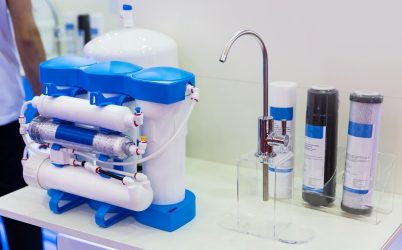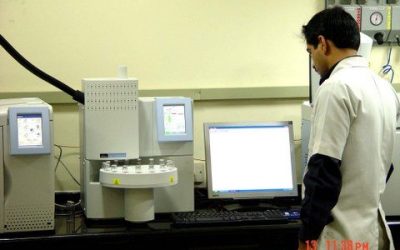
In Pharmaceutical manufacturing CHNS (O) Elemental Analysis is used for characterisation of API and intermediate. It determines the amount of carbon, hydrogen, nitrogen, sulphur, and oxygen in a sample. It is a reliable and cost effective test method which can be used to assure the behavior of pharmaceutical drugs, quality of biofuels, nitrogen in soil and compost CHNS (O) analysis can be used to confirm the purity of products at every stage to maintain and control the production, document and the product quality. Understanding the composition of the organic elements helps the analysts to determine the structure of the sample substance. It allows a fast, accurate assessment of elemental composition to be made with minimal sample preparation. This enables it to be used as a quick screening test to check that a pure chemical is within a defined specification either prior to use or during manufacturing. If impurities are found, more laborious techniques, such as LC-MS, may then be employed to identify the cause of the impurity.To cap it all, the chemical characterization of organic compounds is used in research as well as for quality control (QC).
What is Elemental Analysis?
Elemental analysis is a process where a sample of some material, mineral or chemical compound is analyzed for its elemental composition. It can be qualitative that determines the elements present in it and it can also be quantitative to determine how much of each are present.
CHNS (O) Analysis/Elemental Analysis of Organic Compounds
In CHNS (O) analysis the content of carbon, hydrogen, nitrogen, sulfur, and oxygen is determined. The analysis is performed on pharmaceutical products, petroleum, biofuels, refined fuels, and other hydrocarbon products in solid, liquid, volatile or viscous state. Primarily, CHNS (O) analysis is used across several industries like pharmaceutical, energy, environmental and food industries.
Combustion of the Sample
The combustion of the sample generates uniform compound gasses of the elements C, H, N and S. These combustion products (e.g. CO2, H2O, NO2, etc.) are measured using gas chromatography.
C, H, N and S are determined simultaneously whereas O is analyzed by pyrolysis in the next step. The CHNS content of a sample is determined by weighing the sample and wrapping it in tin boats and for oxygen silver boats . High temperature combustion of the sample (1150°C for CHNS analysis) in an oxygen rich environment oxidizes the sample, this is followed by controlled reduction of the gasses formed during combustion.
Through this process any carbon contained in the sample is converted to CO2, hydrogen to H20, nitrogen to N2 and sulphur to SO2.
CHNS (O) Applications
CHNS analysis gives the percentage composition of each element in a sample. Impurities can easily be identified. Due to the speed of analysis and ease of sample preparation CHNS analysis is suited to being performed during a manufacturing process to monitor the process.
Data produced by CHNSO elemental analysis helps scientists determine the chemical composition and structure of an organic compound. Elemental analysis is a fast, simple and inexpensive technique for determining chemical composition.
Why Weighing is Important in Organic Elemental Analysis ?
Organic elemental analysis requires relatively small sample weights. The actual sample weights vary according to the nature of the substance, the detection limits, the level of accuracy required and the type of elemental analyzer used. As the final amounts of each element are typically given as a percentage of the original sample weight, it is critical that the sample is weighed accurately. Due to the very small sample size, a highly accurate microbalance is recommended.
Accuracy
Weighing out samples of a consistent size is important. As the final results of C, H, N and S content is given as a percentage of the initial sample weight, it is critical to weigh the sample accurately and record the weight correctly.
Sample Usage
Using small sample sizes minimizes substance use, reduces the amount of oxygen required for combustion, and decreases waste. A balance with a low minimum weight helps to minimize the amount of substance required.
Number of Samples
Preparing samples for CHNS(O) analysis is a time and labor-intensive process. Microbalances are very sensitive and can take several seconds to settle before releasing the weight result.
Method and Equipment
We use the latest technology Vario EL Cube to detect the elements Carbon, Hydrogen, Nitrogen, Sulphur and Oxygen at several stages of the manufacturing process of pharmaceutical and chemical products. It can be used prior to manufacturing to confirm the purity of ingredients.
The vario EL cube adjusts to all the analytical needs in elemental analysis with highest precision and accuracy.
The methodology used by CHNSO analysis requires high-temperature combustion in an environment rich in oxygen. The technique, based on the Pregl-Dumas method, carries out combustion under both static and dynamic conditions to produce gases which are then passed through absorbent traps to reduce the sample to just carbon dioxide, water, nitrogen, and sulfur dioxide.
If you would like to use our testing services please feel free to contact us through the contact form or call us now on +91-11-45754575. We will be happy to provide you with a proposal for your testing requirements using CHNS(O) for pharmaceuticals etc.
FAQs
ELEMENTAR, Model– VARIÓ-EL CUBE
C, H, N, S, Test in second run – O
5000/- per sample plus tax.
20 samples of C, H, N, S per day or 20samples of O per day
Solid raw materials and liquid
Pharmaceuticals
For CHNS(O) analysis, the amount of sample should be minimum 50 mg. Use clean vials and label them properly. Solid material must be powdered, homogeneous and well-dried. The presence of dust or moisture in your sample leads to deviations in the results.
















